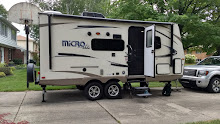.JPG)
Today we began exploring the Texas Hill Country around us. First we stopped by the park office where we learned that the unfamiliar, spotted deer we had seen were Access (or Axis?) deer, exotics that had escaped from Game Farms in the region. We also learned that the fire was in the host’s RV, when no one was home. Germans were some of the primary early settlers of the Hill Country and they have left their mark on the towns and villages throughout the region. We drove first to the Lyndon B. Johnson National Historic Park in Johnson City, which was named for his second cousin, who started the town. In the Visitor Center Marv watched a movie about his presidency while I watched a movie about Lady Bird Johnson. We looked at the timeline exhibit that followed his lifetime and what else was happening in the nation at the same time. Then we took the walking trail around the Johnson Settlement, where we saw his grandparents’ rebuilt cabin and other restored historical structures. There is also an exhibit on open range cattle kingdoms, because that was what his grandfather and his brother did when they settled in the region. On our way out we drove past LBJ’s boyhood home. About 14 miles outside of Johnson City is the LBJ Ranch including his birthplace and the “Texas White House” Complex. They can only be seen if you take a tour bus from the State Park, which we opted not to do. So we continued on to Fredericksburg, a charming town that is rich in the cultural heritage of its German immigrant founders. Located in this birthplace and home of Adm. Chester Nimitz is the National Museum of the Pacific War, George H. W. Bush Gallery. The Gallery is new and just opened on Dec. 7, 2009. It is set up to take you on a “tour” of the war beginning with Japanese, Chinese, and Western relations from the mid 1800’s up through the end of the war. Most of the museum is dedicated to a blow-by-blow description of how the Pacific War took place. There are lots of high tech movies and video maps that could outline the different battles of the war. There were also small stands where you could listen to recorded stories of veterans. Marv had expected to get a little better idea of how his father, a fighter pilot in the Pacific Theater, might have been involved in the war but he was disappointed to find that the Army Air Corps was hardly mentioned and when it was, only in the context of bombing Japan. All of the action described in the many displays seemed to be about naval battles, navy bombardments, the landing of troops and the ensuing battles of foot soldiers on the islands. In three hours we only had time to see the gallery, and no time for the Nimitz museum or to take the tour of the Pacific Combat Zone, a three acre site showcasing the large artifacts. We left when the gallery closed and walked around Fredericksburg a bit before going to what the tourist information said was the oldest brewery in Texas. Imagine our surprise when its sign and coasters said it started in 1994! Oh well, they had good beer and an old-fashioned German Biergarten. By then it was time to head back to the campsite, about 45 minutes away. We had added to our list of unusual animal sightings with herds of bison (at a Heritage Farm near the LBJ Ranch), llamas, and the Access Deer. After a light supper we took a walk around our camping loop by the bright light of the almost full moon.
.JPG)
.JPG)
.JPG)










.JPG)


















.JPG)



